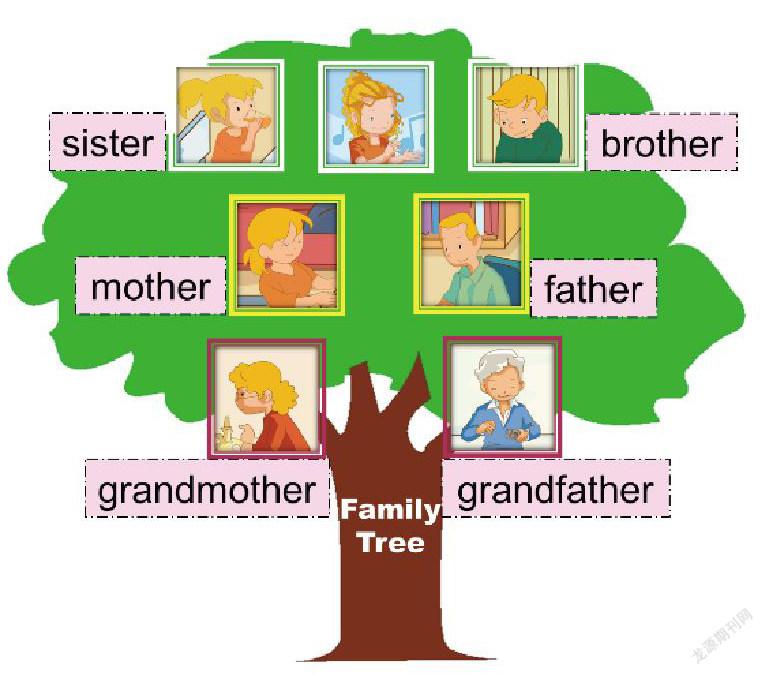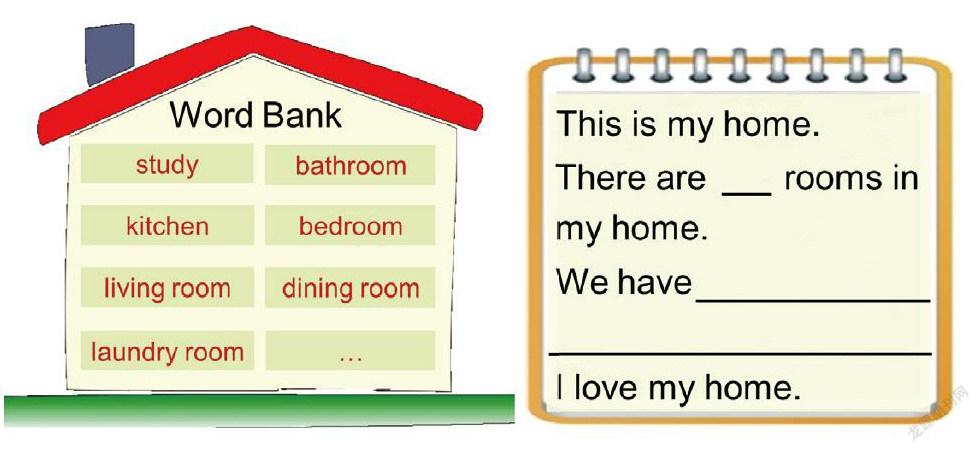“课堂四动”理念在小学英语词汇教学中的应用
2022-03-22余弦


摘 要:“课堂四动”,即情境调动、平台互动、问题驱动、工具撬動,情境调动体验感、问题驱动好奇心、平台增强交互感、工具撬动生长点。词汇是语言学习的基础,词汇教学是小学英语教学的一个重要组成部分。本文将结合线上词汇教学课堂实例,阐述如何将“课堂四动”理念应用于小学英语词汇教学,以期提高课堂教学效率,提升学生英语语言运用能力和学科核心素养。
关键词:课堂四动;词汇教学;核心素养
作者简介:余弦(1989.12.22-),重庆人,清华大学附属小学昌平学校,二级教师,研究方向:英语口语、读写结合、空中课堂、单元主题教学。
“四动”课堂动力系统即问题驱动、情境调动、平台互动、工具撬动,把课上好是基础师德,让学生学会学习才是最崇高的师德。本文选取笔者执教的中国教育电视台同上一堂课直播课堂:人教版《英语》(一年级起点)三年级下册Unit 6 “My Home” Lesson 1的一些教学片段,阐述如何借助“四动”理论丰富并夯实小学英语词汇教学。通过情境调动,增强学生体验感和趣味性;平台互动,让学习真实、有效地发生;问题驱动,培养学生的思维品质;工具撬动,提升学生英语语言运用能力。
一、情境调动,增强学生体验感和趣味性
本课在参观Joy的家这个大情境的设置下,师生围绕主题图进行交流,旨在进行新语言的输入,帮助学生在真实的语境中感知新语言,并引导学生关注图片细节,引发学生发散思维,主动提问,提高学习的真实性和主动性。
教学片段如下:
1. Learn “bedroom”.
T: Welcome to Joy's home! There are many rooms in her home. Her family members are in different rooms. What are they doing? And where are they?
T: Who is she?
S1: She is Joy's grandmother.
T: What's she doing now?
S2: She's watering the plants.
T: Where is she? She is in a big room. Look, there is a big bed in this room. We call this room “bedroom”.(出示词卡bedroom,强调字母e的发音,引导学生尝试自主拼读,之后教师示范正确发音,学生跟读。)
T: What can you do in the bedroom?
S3: I can sleep in the bedroom.
学生跟着Joy,参观各个房间,将各个房间里的人物和活动有联系地串联在一起。
2. Learn “living room”.
Joy:Can you see my grandfather? He is not in his bedroom. Where is he?
T: He is in another room. We can see a TV, a sofa and a tea table in this room. We call this room “living room”.(出示词卡,提示学生living这个词中第一个字母i的发音。)
T: What's he doing?
S4: He's watching TV.
T: What can you do in the living room?
S5: I can watch football games with my father in the living room.
3. Learn “kitchen”.
(教师引导学生观察客厅钟表上的时间。)
T: Look at the clock. What time is it?
S6: It's 11:30.
T: It's lunch time. Who is cooking for the family? Let's go to another room and have a look.
S7: Mom is cooking here.
T: What can you see?
S8: I can see a knife, a pot and some vegetables in this room.
T: What room is it?
S9: Kitchen.(教师出示词卡,提示学生kitchen这个词中字母i的发音。)
T: What can you do in the kitchen?
S10: I can cook and wash dishes in the kitchen.
T: Last Sunday was Mother's Day. I made a cake for my mom in the kitchen. Let's go on to find Joy's father.
4. Learn “study”.
T: Here he is. What's he doing?
S11: He's reading a book.
T: What can you see in this room?
S12: There are many books on the bookshelf. And I can see a desk, a computer and a chair in this room.
T: What room is it?
S13: It's a study.(出示词卡,提示学生study这个词中字母u的发音。)
T: What can you do in the study?
S14: I can read books with my mom in the study.
5. Learn “dining room”.
(教师引导学生观察图片中的两把椅子,自然过渡到下一个房间。)
T: Look, there are another two chairs in this picture. What room is it? Let's have a look.
S15: Oh, there are six chairs and a big table in this room.
T: What room is it?
S16: It's a dining room. (出示词卡,提示学生dining这个词中第一个字母i的发音。)
T: Who is in the dining room?
S17: Joy's sister is in the dining room.
T: What's she doing?
S18: She's drinking juice.
T: What can you do in the dining room?
S19: I can drink and eat with my family in the dining room.
6. Learn “bathroom”.
T: Do you remember this boy?
S20: He is Joy's brother.
T: What's he doing?
S21: He's washing his hands because he wants to eat some food.
T: Before eating or drinking, we need to wash our hands.(渗透生活常识,帮助学生养成餐前洗手的好习惯。)Where is he washing his hands? Is he in the kitchen? No. What can you see in this room?
S22: I can see a sink, a toilet and a shower.
T: We call this room “bathroom”.(出示词卡,提示学生bathroom这个词中字母a的发音。)
T: What can you do in the bathroom?
S23: I can brush my teeth and take a bath in the bathroom.
词汇学习的过程中,学生能感受不同的房间有不同的用处,在各个房间里,学生可以和家人做不同的事情,感受美妙的家庭时光。
学习新词的过程中,也充分利用大情境,按照参观房间的顺序,学习词汇(bedroom, living room, kitchen, study, dining room, bathroom)。用生动的情境丰富词汇教学的方式,加强词汇教学的有效性,做到了在语境中学习词汇,而不是孤立地学习词汇。同时引导学生观察、体会字母在单词中的发音,建立音、形、意的关系。
二、平台互动,让学习真实、有效地发生
如何能让线上的学生真正与课堂有交互感,并参与到学习中,是我们一直都在思考的问题。为此,我们在设计时,一定要思考互动平台的可参与度和可操作性。例如搭建学生与课本主人公之间的互动平台,巩固所学的同时,为后续的输出做好铺垫;搭建游戏互动平台:My Room和Where are my family members?检测学生对知识的掌握程度,利用生动有趣的呈现方式,把理性的知识显性化。教学片段如下:
T: After learning so much about rooms. Let's review by playing a game “My Room”.
T: Look, here is a boy. He wants to watch TV. Where can he watch TV? In the dining room or in the living room.
S24: We watch TV in the living room.(学生依次完成后面的几组练习。)
通過抓娃娃的动画游戏,及时巩固复习6种房间类型的词汇(bedroom, living room, bathroom, dining room, study, kitchen),并联系生活实际,表达各个房间的具体功能,学生借助图片和已有背景知识对选项做出快速判断,从而激发其学习兴趣,同时增强课堂平台互动性。
T: Just now, you visited Joy's home. There are many rooms in her home. Her family members are at home. Where are they? And what are they doing? How to play this game? Let's break the bricks to find her family members behind wall.
Joy:Where is my grandmother? Where is she?
S25:She is in the bedroom. She's watering the plants.(学生和Joy对话,依次完成后面5个房间的练习。)
搭建学生与课本主人公Joy之间的平台互动形式,练习句型Where is... ? He's / She's in the ...巩固所学的同时,用生动有趣的呈现方式,增加环节的趣味性,把抽象知识形象化、生动化,为后续的韵文输出做好铺垫。
三、問题驱动,培养学生的思维品质
教师在本节课通过问题驱动将学习内容的原生价值与学生学习的需求点和生长点连接,形成驱动学生好奇心与内生力的主问题和问题链,进一步激发学生学习的兴趣。借助课前歌曲、课中操练和课后的任务,来引导学生预学、共学和延学,弥补在线教学时间短、互动时间不足的劣势,追踪和强化学习效果。同时,充分关注如何提高儿童的语言习得能力,较好地实现了师生之间的良性互动。
引导学生观察每个房间的特征和功能,在设问中突破词汇教学,例如学习单词bedroom:奶奶在干什么?她在浇花。她在哪里浇花?一个大房间里,这个房间里有床,这样的房间我们把它叫做什么呢?学生根据字母的发音规则,尝试自主拼读出单词bedroom。
四、工具撬动,提升学生英语语言运用能力和英语学科核心素养
工具撬动学习卡点,本课一开始由歌曲“欢迎来我家”自然引入到主人公Joy的家,并借助思维工具Family Tree引出Joy的家庭成员,为后续谁在哪个房间做什么做好铺垫。
在词汇教学环节,除了使用单词的教学录音外,教师还利用词卡这项工具,示范发音,学生听音模仿,确保习得语言的准确性,在保证充分输入的基础上,增强学生输出的自信。
再如,在Practice环节,教师使用沙锤打节奏示范朗读,激发学生兴趣,尝试跟读小韵文,进而巩固和强化功能句型。PPT课件随读效果的呈现,帮助学生在chant环节,把握节奏,吸引学生注意力,有效地提示跟读内容,能够兼顾到不同程度的学生。
在课程的Production环节,学生可以借助房间图纸和句型框架,用一段完整的话介绍自己的家,培养爱家的情感。
在工具的帮助下,引导学生进行语言输出,对自己的家进行更深入全面的介绍。这样能使学生更加直观地感知语言结构和逻辑,同时也使语言的输出与表达更具有逻辑性、层次性和完整性。
参考文献:
[1]义务教育教科书·英语(一年级起点)三年级下册[M].北京:人民教育出版社,2013
[2]窦桂梅.“四轮驱动”的体育课程建构与实践探索——清华附小在成志教育中找寻儿童体育的价值传承[J].中小学信息技术教育,2019(6):36
3046501908224
